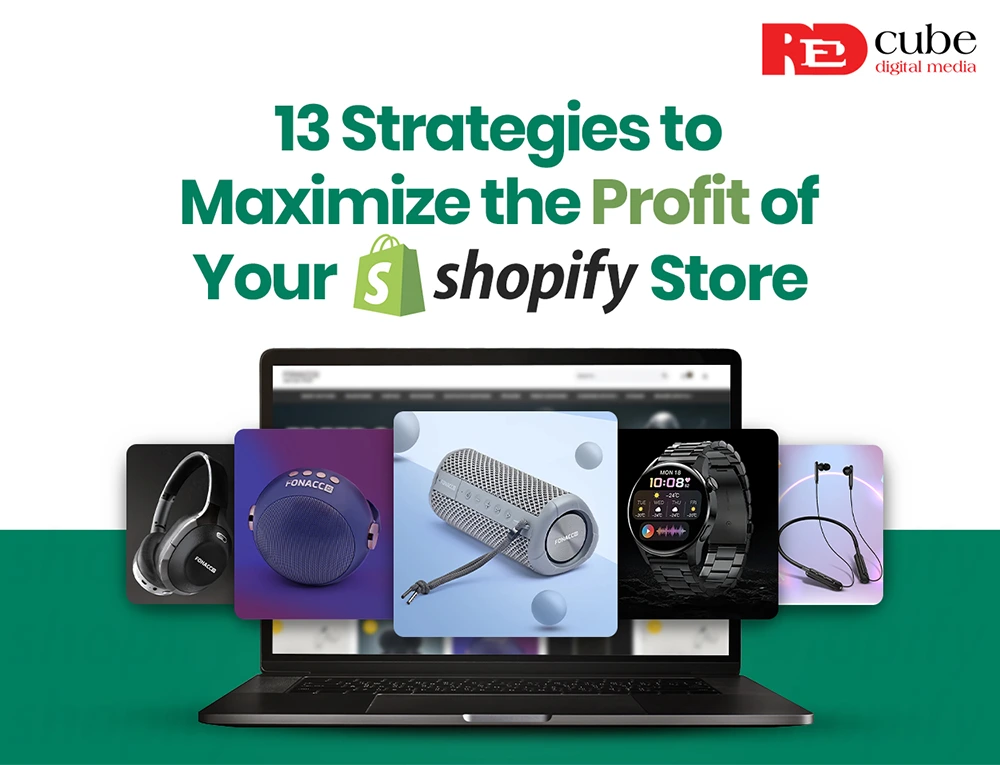Are you tired of your Shopify store not reaching its full potential? In the cutthroat world of e-commerce, simply listing products won’t cut it. Do you ever wonder if there are untapped strategies that could skyrocket your sales and profitability?
Dive into this comprehensive guide, where we uncover the little-known techniques and best practices that can catapult your Shopify store to new heights of success. Get ready to revolutionize your approach and leave your competition in the dust.
Understanding Shopify Store Profitability
Before diving into specific strategies, it’s crucial to understand what drives profitability in a Shopify store. At its core, profitability is the result of:
- Revenue
- Cost of Goods Sold (COGS)
- Operating Expenses
The total amount of money generated from sales
The direct costs associated with producing or purchasing the products you sell
Costs related to running your business, such as marketing, hosting, and software subscriptions
Your profit is the amount left over after subtracting COGS and operating expenses from your revenue. To maximize profit, you need to focus on increasing revenue while optimizing your costs.
5 Solid Strategies to Boost Revenue
- Optimize Your Product Offerings
- Enhance Your Website Design and User Experience
- Implement Effective Marketing Strategies
- Optimize Your Pricing Strategy
- Enhance Customer Retention and Loyalty
Conduct thorough market research
your target audience and their needs is crucial for selecting products that will sell well. Use tools like Google Trends, social media listening, and competitor analysis to identify popular products and emerging trends in your niche.
Implement product bundling
Create attractive product bundles that offer value to customers while increasing your average order value. For example, if you sell skincare products, you could bundle a cleanser, toner, and moisturizer as a complete skincare set.
Utilize cross-selling and upselling techniques
Recommend related or upgraded products to customers based on their browsing and purchase history. Shopify apps like Bold Upsell or Frequently Bought Together can help automate this process.
Improve site speed and performance
A fast-loading website is crucial for conversion rates. According to a study by Portent, website conversion rates drop by an average of 4.42% with each additional second of load time (between 0-5 seconds). Use tools like Google PageSpeed Insights to identify and fix performance issues.
Optimize for mobile devices
With mobile commerce accounting for 72.9% of all e-commerce sales in 2021 (Statista), ensuring your Shopify store is fully responsive and mobile-friendly is essential.
Implement clear and compelling product descriptions
Write detailed, benefit-focused product descriptions that address potential customer questions and concerns. Use high-quality images and videos to showcase your products effectively.
Leverage email marketing
Email marketing remains one of the most effective channels for e-commerce, with an average ROI of $42 for every $1 spent (DMA, 2019). Build your email list and create targeted campaigns for different customer segments.
Utilize social media marketing
Develop a strong presence on platforms where your target audience spends time. Use a mix of organic content and paid advertising to drive traffic and sales.
Implement a content marketing strategy
Create valuable content that attracts and engages your target audience. This can include blog posts, videos, infographics, and user-generated content
Implement dynamic pricing
Use tools like Prisync or Competera to monitor competitor prices and adjust your own pricing strategy accordingly
Offer tiered pricing options
Create different pricing tiers for your products or services to cater to various customer segments and budgets.
Use psychological pricing techniques
Implement strategies like charm pricing (ending prices with .99 or .97) or anchoring (displaying a higher “original” price alongside the discounted price) to influence purchasing decisions.
Implement a loyalty program
Reward repeat customers with points, discounts, or exclusive offers. According to a study by Bain & Company increasing customer retention rates by 5% can increase profits by 25% to 95%.
Provide excellent customer service
Respond promptly to customer inquiries and resolve issues efficiently. Consider implementing live chat or chatbot solutions to provide 24/7 support.
Create a personalized shopping experience
Use customer data to tailor product recommendations, email campaigns, and on-site content to individual preferences and behaviors.
3 Solid Strategies to Optimize Costs
- Streamline Your Supply Chain
- Reduce Operating Expenses
- Leverage Shopify’s Built-in Tools and Third-party Apps
Negotiate better terms with suppliers
As your business grows, leverage your increased purchasing power to negotiate better prices or payment terms with your suppliers.
Consider dropshipping for certain products
Dropshipping can help you expand your product range without incurring additional inventory costs. However, be sure to carefully vet suppliers to maintain quality control.
Optimize inventory management
Use inventory management tools to track stock levels, forecast demand, and avoid overstocking or stockouts
Analyze and optimize your marketing spend
Regularly review your marketing campaigns and focus on channels with the highest ROI. Use tools like Google Analytics to track the performance of different marketing initiatives.
Automate repetitive tasks
Implement automation tools for tasks like order processing, customer service, and inventory management to reduce labor costs and improve efficiency.
Optimize your shipping strategy
Consider offering free shipping thresholds to encourage larger orders, and use shipping rate calculators to ensure you’re not undercharging for shipping costs.
Utilize Shopify’s analytics tools
Make data-driven decisions by regularly reviewing your store’s performance metrics in Shopify’s analytics dashboard.
Implement abandoned cart recovery
Use Shopify’s abandoned cart recovery feature or third-party apps to remind customers about items left in their carts, potentially recovering lost sales.
Explore tax automation tools
Use apps like TaxJar or Avalara to automate sales tax calculations and filings, saving time and reducing the risk of errors.
5 Advanced Strategies for Long-term Profitability
- Develop a Strong Brand Identity
- Expand Your Sales Channels
- Invest in Customer Education and Experience
- Focus on Sustainability and Social Responsibility
- Continuously Test and Optimize
Create a compelling brand story
Develop a unique brand narrative that resonates with your target audience and differentiates you from competitors.
Maintain consistent branding across all touchpoints
Ensure your brand’s visual identity and messaging are consistent across your website, social media channels, packaging, and customer communications.
Explore multichannel selling
In addition to your Shopify store, consider selling on marketplaces like Amazon, eBay, or Etsy to reach a wider audience.
Implement social commerce
Set up shoppable posts on platforms like Instagram and Facebook to allow customers to purchase directly from your social media content.
Create educational content
Develop product guides, tutorials, and FAQs to help customers make informed purchasing decisions and get the most out of your products.
Implement augmented reality (AR) features
For applicable products, consider using AR to allow customers to visualize items in their own space before purchasing.
Implement eco-friendly practices
Consider using sustainable packaging, offsetting carbon emissions, or offering eco-friendly product alternatives.
Support social causes
Align your brand with social causes that resonate with your target audience. According to a study by Cone Communications, 87% of consumers will purchase a product because a company advocated for an issue they cared about.
Implement A/B testing
Regularly test different elements of your store, such as product pages, checkout process, and email campaigns, to identify opportunities for improvement.
Stay updated with e-commerce trends
Keep abreast of the latest e-commerce trends and technologies to ensure your Shopify store remains competitive in the ever-evolving digital landscape.
RedCube Recommends
To further enhance your understanding of e-commerce and Shopify optimization, consider exploring these books:
- “The E-Commerce Playbook: How to Build a Digital Brand” by Anthony Coundouris
- “Shopify Empire: The Definitive Guide to Building a Successful Online Business” by Djemal Maci
- “The $100 Startup: Reinvent the Way You Make a Living, Do What You Love, and Create a New Future” by Chris Guillebeau
- “Jab, Jab, Jab, Right Hook: How to Tell Your Story in a Noisy Social World” by Gary Vaynerchuk
The Final Note
Maximizing the profit of your Shopify store requires a multifaceted approach that combines revenue-boosting strategies with cost-optimization techniques. By implementing the strategies outlined in this guide, you can create a more profitable and sustainable e-commerce business.
Remember that success in e-commerce is an ongoing process. Continuously analyze your store’s performance, stay attuned to customer needs and market trends, and be willing to adapt your strategies as necessary.
We’d love to hear about your experiences with optimizing your Shopify store. What strategies have worked best for you? What challenges have you faced?
Share your thoughts in the comments below, and let’s create a community of successful Shopify entrepreneurs.
If you’re looking for personalized assistance in maximizing your Shopify store’s profitability, don’t hesitate to reach out to the team at Red Cube Digital. Our e-commerce experts are ready to help you take your online business to the next level.
FAQs
Q: How long does it typically take to see results from these profit-maximizing strategies?
A: The timeline for seeing results can vary depending on factors such as your niche, competition, and the specific strategies implemented. Some changes, like optimizing your website’s speed or implementing abandoned cart recovery, can show results relatively quickly (within a few weeks to a month).Other strategies, like building a strong brand identity or developing a content marketing strategy, may take several months to a year to yield significant results. Consistency and patience are key.
Q: Is it necessary to implement all these strategies at once?
A: It’s generally not advisable to implement all strategies simultaneously, as this can be overwhelming and make it difficult to track which changes are having the most impact. Instead, prioritize strategies based on your store’s current needs and resources. Start with a few key areas, measure the results, and then gradually implement additional strategies over time.
Q: How much should I invest in marketing to maximize my Shopify store’s profits?
A: The ideal marketing budget can vary widely depending on your industry, target audience, and business goals. However, a common benchmark for e-commerce businesses is to allocate 7-12% of revenue to marketing. Start conservatively and gradually increase your budget as you identify which marketing channels provide the best ROI for your store.
Q: Can I maximize profits without compromising on product quality or customer service?
A: Absolutely. In fact, maintaining high product quality and excellent customer service are crucial for long-term profitability. These factors contribute to customer satisfaction, repeat purchases, and positive word-of-mouth marketing. The goal is to find ways to increase efficiency and reduce unnecessary costs without sacrificing the quality of your products or customer experience.
Q: How often should I review and adjust my profit-maximizing strategies?
A: Regular review and adjustment of your strategies are essential for continued success. At a minimum, conduct a thorough quarterly review of your store’s performance and strategies. However, you should also be monitoring key metrics on a weekly or monthly basis to identify any immediate issues or opportunities. Be prepared to make more frequent adjustments during peak selling seasons or in response to significant market changes.



